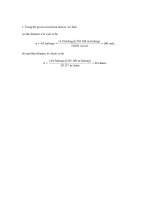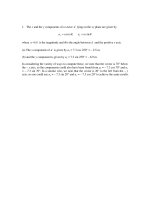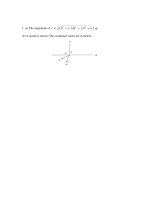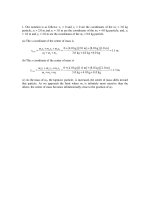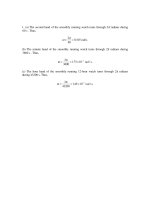Solution manual fundamentals of physics extended, 8th editionch19
Bạn đang xem bản rút gọn của tài liệu. Xem và tải ngay bản đầy đủ của tài liệu tại đây (855.09 KB, 101 trang )
1. Each atom has a mass of m = M/NA, where M is the molar mass and NA is the
Avogadro constant. The molar mass of arsenic is 74.9 g/mol or 74.9 × 10–3 kg/mol. 7.50
× 1024 arsenic atoms have a total mass of (7.50 × 1024) (74.9 × 10–3 kg/mol)/(6.02 × 1023
mol–1) = 0.933 kg.
2. (a) Eq. 19-3 yields n = Msam/M = 2.5/197 = 0.0127 mol.
(b) The number of atoms is found from Eq. 19-2:
N = nNA = (0.0127)(6.02 × 1023) = 7.64 × 1021.
3. (a) We solve the ideal gas law pV = nRT for n:
(
)
(100 Pa ) 1.0 ×10−6 m3
pV
n=
=
= 5.47 × 10−8 mol.
RT ( 8.31J/mol ⋅ K )( 220 K )
(b) Using Eq. 19-2, the number of molecules N is
(
N = nN A = 5.47 × 10−6 mol
) ( 6.02 × 10
23
)
mol−1 = 3.29 × 1016 molecules.
4. With V = 1.0 × 10–6 m3, p = 1.01 × 10–13 Pa, and T = 293 K, the ideal gas law gives
(
)(
)
1.01 × 10−13 Pa 1.0 × 10−6 m3
pV
=
= 4.1 × 10 −23 mole.
n=
RT
8.31
J/mol
⋅
K
293
K
(
)(
)
Consequently, Eq. 19-2 yields N = nNA = 25 molecules. We can express this as a ratio
(with V now written as 1 cm3) N/V = 25 molecules/cm3.
5. (a) In solving pV = nRT for n, we first convert the temperature to the Kelvin scale:
T = (40.0 + 273.15) K = 313.15 K . And we convert the volume to SI units: 1000 cm3 =
1000 × 10–6 m3. Now, according to the ideal gas law,
(
)(
)
1.01 × 105 Pa 1000 × 10−6 m3
pV
n=
=
= 3.88 × 10−2 mol.
RT
(8.31J/mol ⋅ K )( 313.15 K )
(b) The ideal gas law pV = nRT leads to
(
(
)(
)
1.06 × 105 Pa 1500 × 10−6 m3
pV
T=
=
= 493K.
nR
3.88 × 10−2 mol ( 8.31J/mol ⋅ K )
)
We note that the final temperature may be expressed in degrees Celsius as 220°C.
6. Since (standard) air pressure is 101 kPa, then the initial (absolute) pressure of the air is
pi = 266 kPa. Setting up the gas law in ratio form (where ni = nf and thus cancels out —
see Sample Problem 19-1), we have
pfVf
piVi
=
§ 1.64 × 10−2 m3 · § 300 K ·
p f = ( 266 kPa ) ¨
¸
−2
3 ¸ ¨
Ti
© 1.67 × 10 m ¹ © 273K ¹
Tf
which yields pf = 287 kPa. Expressed as a gauge pressure, we subtract 101 kPa and obtain
186 kPa.
7. (a) With T = 283 K, we obtain
(100 ´ 103 Pa )(2.50 m3 )
pV
n=
=
= 106 mol.
RT
(8.31J/mol ×K )(283 K )
(b) We can use the answer to part (a) with the new values of pressure and temperature,
and solve the ideal gas law for the new volume, or we could set up the gas law in ratio
form as in Sample Problem 19-1 (where ni = nf and thus cancels out):
pfVf
piVi
=
Tf
§ 100 kPa · § 303K ·
V f = 2.50 m3 ¨
¸ ¨
¸
Ti
© 300 kPa ¹ © 283K ¹
(
which yields a final volume of Vf = 0.892 m3.
)
8. (a) Eq. 19-45 (which gives 0) implies Q = W. Then Eq. 19-14, with T = (273 + 30.0)K
leads to gives Q = –3.14 × 103 J, or | Q | = 3.14 × 103 J.
(b) That negative sign in the result of part (a) implies the transfer of heat is from the gas.
9. The pressure p1 due to the first gas is p1 = n1RT/V, and the pressure p2 due to the
second gas is p2 = n2RT/V. So the total pressure on the container wall is
p = p1 + p2 =
n1 RT n2 RT
RT
+
= ( n1 + n2 )
.
V
V
V
The fraction of P due to the second gas is then
p2
n2 RT / V
n2
0.5
=
=
=
= 0.2.
p
( n1 + n2 )( RT / V ) n1 + n2 2 + 0.5
10. Using Eq. 19-14, we note that since it is an isothermal process (involving an ideal gas)
then
Q = W = nRT ln(Vf /Vi)
applies at any point on the graph. An easy one to read is Q = 1000 J and Vf = 0.30 m3,
and we can also infer from the graph that Vi = 0.20 m3. We are told that n = 0.825 mol,
so the above relation immediately yields T = 360 K.
11. Since the pressure is constant the work is given by W = p(V2 – V1). The initial volume
is V1 = ( AT1 − BT12 ) p , where T1=315 K is the initial temperature, A =24.9 J/K and
B=0.00662 J/K2. The final volume is V2 = ( AT2 − BT22 ) p , where T2=315 K. Thus
W = A(T2 − T1 ) − B(T22 − T12 )
= (24.9 J/K)(325 K − 315 K) − (0.00662 J/K 2 )[(325 K) 2 − (315 K) 2 ] = 207 J.
.
12. (a) At point a, we know enough information to compute n:
(
)
( 2500 Pa ) 1.0 m3
pV
n=
=
= 1.5 mol.
RT ( 8.31 J/mol ⋅ K ) ( 200 K )
(b) We can use the answer to part (a) with the new values of pressure and volume, and
solve the ideal gas law for the new temperature, or we could set up the gas law as in
Sample Problem 19-1 in terms of ratios (note: na = nb and cancels out):
§ 7.5 kPa · § 3.0 m3 ·
pbVb Tb
=
Tb = ( 200 K ) ¨
¸¨
3 ¸
paVa Ta
© 2.5 kPa ¹ © 1.0 m ¹
which yields an absolute temperature at b of Tb = 1.8×103 K.
(c) As in the previous part, we choose to approach this using the gas law in ratio form
(see Sample Problem 19-1):
§ 2.5 kPa · § 3.0 m3 ·
pcVc Tc
=
Tc = ( 200 K ) ¨
¸¨
3 ¸
paVa Ta
© 2.5 kPa ¹ © 1.0 m ¹
which yields an absolute temperature at c of Tc = 6.0×102 K.
(d) The net energy added to the gas (as heat) is equal to the net work that is done as it
progresses through the cycle (represented as a right triangle in the pV diagram shown in
Fig. 19-19). This, in turn, is related to ± “area” inside that triangle (with
area = 12 (base)(height) ), where we choose the plus sign because the volume change at
the largest pressure is an increase. Thus,
Qnet = Wnet =
(
1
2.0 m 3
2
) ( 5.0 × 10
3
)
Pa = 5.0 × 103 J.
13. Suppose the gas expands from volume Vi to volume Vf during the isothermal portion
of the process. The work it does is
W =
ũ
Vf
p dV = nRT
Vi
ũ
Vf
Vi
V
dV
= nRT ln f ,
V
Vi
where the ideal gas law pV = nRT was used to replace p with nRT/V. Now Vi = nRT/pi
and Vf = nRT/pf, so Vf/Vi = pi/pf. Also replace nRT with piVi to obtain
W = piVi ln
pi
.
pf
Since the initial gauge pressure is 1.03 ì 105 Pa, pi = 1.03 ì 105 Pa + 1.013 ì 105 Pa =
2.04 ì 105 Pa. The final pressure is atmospheric pressure: pf = 1.013 ì 105 Pa. Thus
Đ 2.04 ì 105 Pa ã
4
W = 2.04 ì 105 Pa 0.14 m3 ln ă
á = 2.00 ì 10 J.
5
â 1.013 ì 10 Pa ạ
(
)(
)
During the constant pressure portion of the process the work done by the gas is W =
pf(Vi Vf). The gas starts in a state with pressure pf, so this is the pressure throughout this
portion of the process. We also note that the volume decreases from Vf to Vi. Now Vf =
piVi/pf, so
ổ
p V ửữ
W = p f ỗỗỗVi - i i ữ
= ( p f - pi )Vi = (1.013 105 Pa - 2.04 105 Pa )(0.14 m3 )
ữ
ữ
ỗố
pf ứ
= - 1.44 104 J.
The total work done by the gas over the entire process is
W = 2.00 ì 104 J 1.44 ì 104 J = 5.60 ì 103 J.
14. We assume that the pressure of the air in the bubble is essentially the same as the
pressure in the surrounding water. If d is the depth of the lake and ρ is the density of
water, then the pressure at the bottom of the lake is p1 = p0 + ρgd, where p0 is
atmospheric pressure. Since p1V1 = nRT1, the number of moles of gas in the bubble is n =
p1V1/RT1 = (p0 + ρgd)V1/RT1, where V1 is the volume of the bubble at the bottom of the
lake and T1 is the temperature there. At the surface of the lake the pressure is p0 and the
volume of the bubble is V2 = nRT2/p0. We substitute for n to obtain
V2 =
T2 p0 + ρ gd
V1
T1
p0
(
)(
)
§ 1.013 × 105 Pa + 0.998 × 103 kg/m3 9.8 m/s 2 ( 40 m ) ·
¨
¸ 20 cm3
5
¨
¸
1.013 × 10 Pa
©
¹
2
3
= 1.0 × 10 cm .
§ 293 K ·
=¨
¸
© 277 K ¹
(
)
15. When the valve is closed the number of moles of the gas in container A is nA =
pAVA/RTA and that in container B is nB = 4pBVA/RTB. The total number of moles in both
containers is then
n = nA + nB =
VA § p A 4 pB ·
+
¨
¸ = const.
R © TA TB ¹
After the valve is opened the pressure in container A is p′A = Rn′ATA/VA and that in
container B is p′B = Rn′BTB/4VA. Equating p′A and p′B, we obtain Rn′ATA/VA = Rn′BTB/4VA,
or n′B = (4TA/TB)n′A. Thus,
§
4T ·
V §p
4 pB ·
n = n′A + n′B = n′A ¨1 + A ¸ = nA + nB = A ¨ A +
¸.
TB ¹
R © TA
TB ¹
©
We solve the above equation for n′A:
n ¢A =
V ( p A TA + 4 pB TB )
.
R
(1+ 4TA TB )
Substituting this expression for n′A into p′VA = n′ARTA, we obtain the final pressure:
p′ =
n′A RTA
p + 4 pBTA / TB
= A
= 2.0 × 105 Pa.
VA
1 + 4TA / TB
16. The molar mass of argon is 39.95 g/mol. Eq. 19–22 gives
vrms =
3 ( 8.31J/mol ⋅ K )( 313K )
3RT
=
= 442 m/s.
M
39.95 × 10 −3 kg/mol
17. According to kinetic theory, the rms speed is
vrms =
3RT
M
where T is the temperature and M is the molar mass. See Eq. 19-34. According to Table
19-1, the molar mass of molecular hydrogen is 2.02 g/mol = 2.02 × 10–3 kg/mol, so
vrms =
3 ( 8.31J/mol ⋅ K )( 2.7 K )
−3
2.02 × 10 kg/mol
= 1.8 ×102 m/s.
18. Appendix F gives M = 4.00 × 10–3 kg/mol (Table 19-1 gives this to fewer significant
figures). Using Eq. 19-22, we obtain
vrms =
3RT
=
M
3 (8.31 J/mol ×K )(1000 K )
- 3
4.00 ´ 10 kg/mol
= 2.50 ´ 103 m/s.
19. Table 19-1 gives M = 28.0 g/mol for nitrogen. This value can be used in Eq. 19-22
with T in Kelvins to obtain the results. A variation on this approach is to set up ratios,
using the fact that Table 19-1 also gives the rms speed for nitrogen gas at 300 K (the
value is 517 m/s). Here we illustrate the latter approach, using v for vrms:
3RT2 / M
v2
T
=
= 2.
v1
T1
3RT1 / M
(a) With T2 = (20.0 + 273.15) K ≈ 293 K, we obtain
v2 = ( 517 m/s )
293K
= 511m/s.
300 K
(b) In this case, we set v3 = 12 v2 and solve v3 / v2 = T3 / T2 for T3:
2
2
§v ·
§1·
T3 = T2 ¨ 3 ¸ = ( 293 K ) ¨ ¸ = 73.0 K
©2¹
© v2 ¹
which we write as 73.0 – 273 = – 200°C.
(c) Now we have v4 = 2v2 and obtain
2
§v ·
T4 = T2 ¨ 4 ¸ = ( 293K )( 4 ) = 1.17 × 103 K
© v2 ¹
which is equivalent to 899°.
20. First we rewrite Eq. 19-22 using Eq. 19-4 and Eq. 19-7:
vrms =
3 ( kN A ) T
3RT
3kT
=
=
.
M
M
( mN A )
The mass of the electron is given in the problem, and k = 1.38 × 10–23 J/K is given in the
textbook. With T = 2.00 × 106 K, the above expression gives vrms = 9.53 × 106 m/s. The
pressure value given in the problem is not used in the solution.
21. In the reflection process, only the normal component of the momentum changes, so
for one molecule the change in momentum is 2mv cosθ, where m is the mass of the
molecule, v is its speed, and θ is the angle between its velocity and the normal to the wall.
If N molecules collide with the wall, then the change in their total momentum is 2Nmv
cos θ, and if the total time taken for the collisions is ∆t, then the average rate of change of
the total momentum is 2(N/∆t)mv cosθ. This is the average force exerted by the N
molecules on the wall, and the pressure is the average force per unit area:
p=
2§N ·
mv cosθ
A ¨© ∆t ¸¹
§
·
2
1.0 × 1023 s −1 3.3 × 10−27 kg 1.0 × 103 m/s cos 55°
=¨
−4
2 ¸
2.0
10
m
×
©
¹
3
= 1.9 × 10 Pa.
(
)(
)(
)
We note that the value given for the mass was converted to kg and the value given for the
area was converted to m2.
22. We can express the ideal gas law in terms of density using n = Msam/M:
pV =
M sam RT
pM
ρ =
.
M
RT
We can also use this to write the rms speed formula in terms of density:
vrms =
3RT
=
M
3( pM / ρ )
=
M
3p
ρ
.
(a) We convert to SI units: ρ = 1.24 × 10–2 kg/m3 and p = 1.01 × 103 Pa. The rms speed is
3(1010) / 0.0124 = 494 m/s.
(b) We find M from ρ = pM/RT with T = 273 K.
(0.0124 kg/m3 ) (8.31J/mol ×K )(273K)
r RT
=
= 0.0279 kg/mol = 27.9 g/mol.
M =
p
1.01 ´ 103 Pa
(c) From Table 19.1, we identify the gas to be N2.
23. The average translational kinetic energy is given by K avg = 32 kT , where k is the
Boltzmann constant (1.38 × 10–23 J/K) and T is the temperature on the Kelvin scale. Thus
K avg =
3
(1.38 × 10−23 J/K) (1600 K) = 3.31 × 10 −20 J .
2
24. (a) Eq. 19-24 gives K avg =
3§
−23 J ·
−21
¨ 1.38 × 10
¸ (273K) = 5.65 × 10 J .
2©
K¹
(b) Similarly, for T = 373 K, the average translational kinetic energy is
K avg = 7.72 × 10−21 J .
(c) The unit mole may be thought of as a (large) collection: 6.02 × 1023 molecules of ideal
gas, in this case. Each molecule has energy specified in part (a), so the large collection
has a total kinetic energy equal to
K mole = N A K avg = (6.02 × 1023 ) (5.65 × 10−21 J) = 3.40 × 103 J.
(d) Similarly, the result from part (b) leads to
K mole = (6.02 × 1023 ) (7.72 × 10−21 J) = 4.65 × 103 J.
25. (a) We use ε = LV/N, where LV is the heat of vaporization and N is the number of
molecules per gram. The molar mass of atomic hydrogen is 1 g/mol and the molar mass
of atomic oxygen is 16 g/mol so the molar mass of H2O is (1.0 + 1.0 + 16) = 18 g/mol.
There are NA = 6.02 × 1023 molecules in a mole so the number of molecules in a gram of
water is (6.02 × 1023 mol–1)/(18 g/mol) = 3.34 × 1022 molecules/g. Thus
ε = (539 cal/g)/(3.34 × 1022/g) = 1.61 × 10–20 cal = 6.76 × 10–20 J.
(b) The average translational kinetic energy is
K avg =
3
3
kT = (1.38 × 10 −23 J/K)[(32.0 + 273.15) K] = 6.32 × 10−21 J.
2
2
The ratio ε/Kavg is (6.76 × 10–20 J)/(6.32 × 10–21 J) = 10.7.
